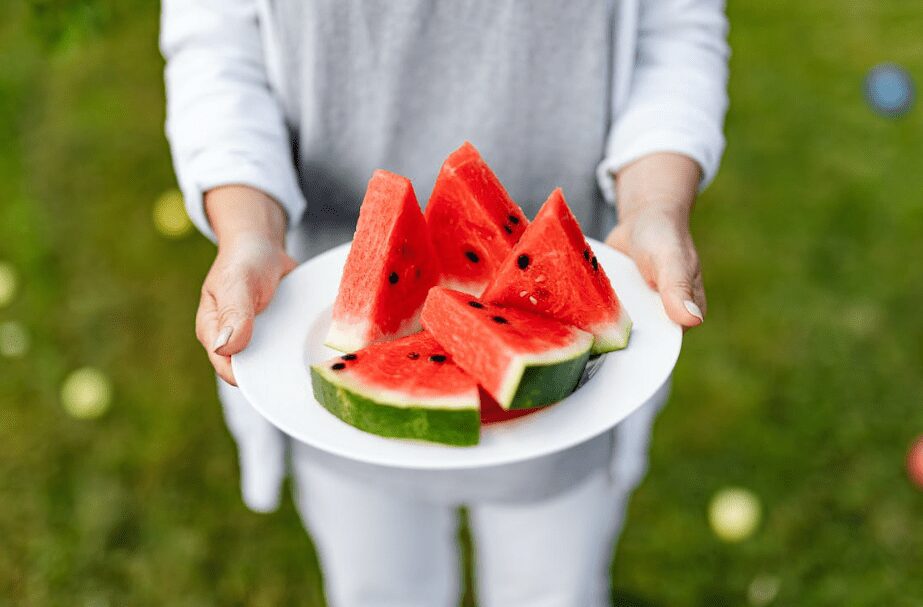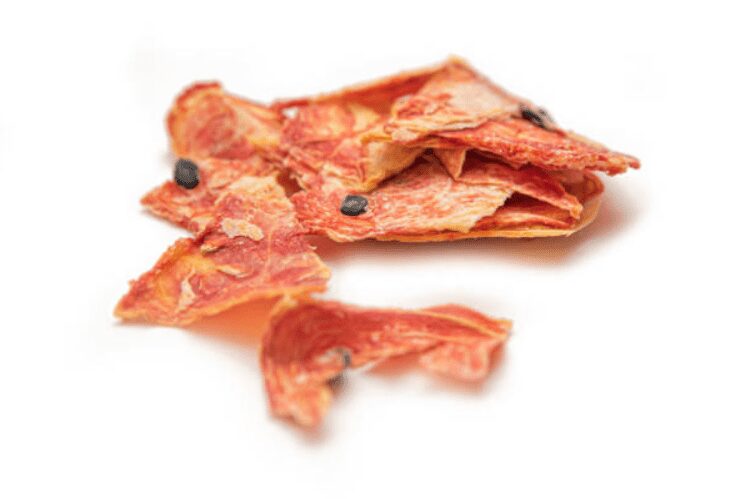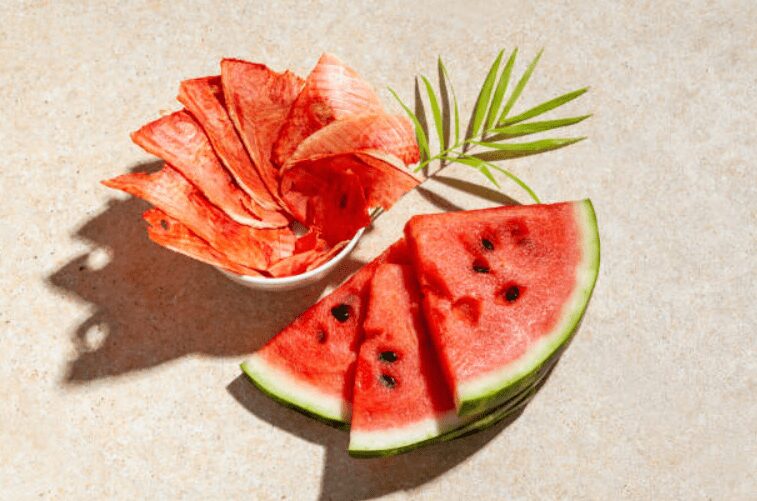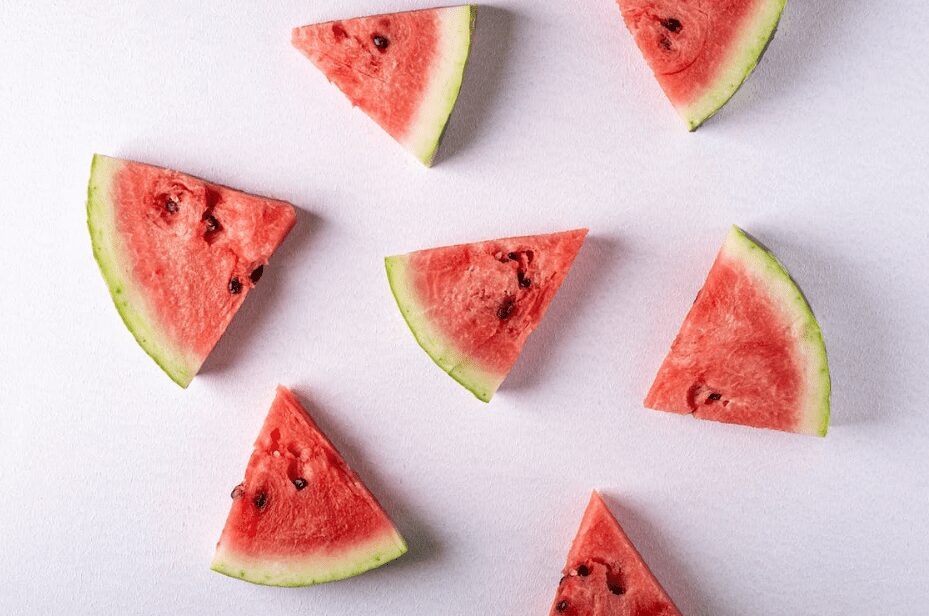Dehydrating watermelon is a great way to preserve a bumper crop or take advantage of a good deal. The process is easy and requires minimal effort. The end result is an addictive snack that tastes only better – sweet, slightly chewy, and with concentrated real fruit flavor.
Dehydrating watermelon can be used as a healthy snack for those looking for something sweet without added sugar or preservatives. It is also an effective way to avoid food waste when there is too much watermelon available.
Dried watermelon can be served at summer barbecues or preserved for winter snacking. It’s also great for camping trips or hikes where you need something light and nutritious to keep your energy levels up throughout the day.
Dehydrating watermelon can help you make the most of your harvest while still enjoying its delicious flavor all year round.
How To Dehydrate Watermelon

To make it, you’ll need a fresh seedless watermelon and a dehydrator with trays. Dehydrating watermelon requires an airtight container and a sharp knife, as well as a desiccant packet and parchment paper or paraflexx sheets to help keep moisture away.
Below are the step-by-step instructions for those who want to try dehydrating watermelon.
1) Prepare The Watermelon
Preparing a watermelon for drying is a simple process that requires just a few steps. To start, it’s best to use a room-temperature watermelon. This will ensure the best flavor and texture when it is dried.
After selecting the perfect watermelon, rinse it in cold water to remove any dirt or debris from the outside of the fruit.
Using a sharp knife, cut the watermelon into large chunks and then remove the rind. Once this is done, slice each chunk into thick pieces at least 1/4 inch thick to 1/2 inch thick slices.
It’s important to keep the slices as uniform in thickness as possible so they will dry evenly. If you cut them too thin, they will shrink down significantly during the drying process.
With these simple steps, you’ll have a perfectly prepared watermelon ready for drying.
2) Load In The Dehydrator Trays
When loading the dehydrator trays with watermelon slices, it is important to ensure that each slice has enough room around it so that it can dry properly. It is also essential to make sure that the slices are evenly spaced on the tray so they will all dry at an even rate.
3) Dehydrating Process
The drying process for watermelon candy is a lengthy one, but it’s worth the wait. Place the trays into the dehydrator and set them to 135 degrees Fahrenheit.
The dehydration process can take up to 12 hours, so it’s best to start this before going to bed. Let the watermelon dry overnight and in the morning you’ll have delicious dehydrated watermelon jerky.
It’s important to note that because of its high water content, watermelon takes longer than other fruits or vegetables to dry out completely.
This means that you should check on your progress periodically throughout the night and adjust the temperature if needed. With patience and care, you can create a delicious snack that will last for weeks.
4) Let Them Cool Before Storing
When making watermelon fruit leather, it is important to let the strips cool before storing them. Heat can draw moisture from the leather and make it soggy. To prevent this, allow the strips to cool on the dehydrator trays until they are completely dry.
Once cooled, remove the strips and place them in an airtight container such as a canning jar. This will help keep moisture away and ensure that it stays fresh for longer.
To further protect your watermelon fruit leather, you can add a food grade desiccant packet. Desiccants absorb any excess moisture in the air and help keep your fruit leather dry and crisp.
Is It Possible To Dehydrate Watermelon Using An Oven?

Dehydrating watermelon in the oven is a possible option, but it may not be the best one. A food dehydrator is the preferred method for drying out watermelons due to their high water content. The even heat and fan blowing help to dry out the fruit quickly and evenly.
If you don’t have access to a dehydrator, however, you can try using your oven. Place your watermelon slices on a baking rack inside of a cookie sheet and set your oven to its lowest temperature with the door slightly open to let moisture escape. This process will take several hours, so be sure to check on it periodically.
When dehydrating watermelon in the oven, it’s important to keep an eye on it as it dries out. You want to make sure that it doesn’t get too dry or burn, so adjust the temperature if necessary and keep checking on it until you reach your desired texture.
Dehydrated watermelon makes for a delicious snack or addition to salads and other dishes, so give this method a try if you don’t have access to a food dehydrator.
What Does Dehydrated Watermelon Tastes Like?
Dehydrated watermelon is a fantastic snack for those looking for a sweet treat without the guilt. It has all the flavor of regular watermelon, but with an intensified sweetness and flavor.
The texture is like that of watermelon taffy, chewy and stretchy when you bite into it. It’s like having a watermelon jolly ranchers candy without all the added sugar and calories.
Dehydrated watermelon is a healthy alternative to traditional sugary snacks and candies. Not only does it taste so good, but it also provides essential vitamins and minerals that are beneficial to your health.
It’s perfect for kids who love sweets, as well as adults who want something sweet without feeling guilty about indulging in unhealthy snacks. Dehydrated watermelon is sure to be a hit with everyone in your family.
Uses Of Dehydrated Watermelon

1) Conserving The Flavor – Dehydrating watermelons is a fantastic strategy to extend the enjoyment of the watermelon crop.
2) Another Method of Consuming A Watermelon – Envision consuming your favorite fruit without any mess.
3) Simple To Carry – Dehydrated watermelon is a tasty hiking, camping, or picnic food. Slices of dehydrated watermelon are simple to carry to any place you go in a jar or a zip-lock bag.
4) Long-term Storage Through Preservation – This is an additional method to preserve watermelon without requiring refrigeration. Dehydrated watermelon can be used in a variety of ways, making them a useful ingredient to keep on hand.
How To Pick A Watermelon
When it comes to picking a watermelon, the most important factor is taste. A watermelon that is mealy or tasteless will not make for a good dehydrated snack. Instead, look for one that feels heavy for its size and has a rich color.
The best watermelons are those that have been allowed to ripen on the ground instead of being picked early; these will have a patchy area where it is yellow/brownish, which is perfectly fine.
To test if the watermelon is ripe, give it a gentle thump with your knuckles and listen for a hollow sound. If you hear this sound, then the melon should be ready to eat or dehydrate. Additionally, look for any cracks in the rind as this could indicate an overripe melon.
Finally, check the underside of the melon; if it’s creamy yellow in color then it’s likely ripe and ready to go! With these tips in mind, you can easily pick out a delicious watermelon every time.
Conditioning After Dehydrating

Conditioning after dehydrating is an important step in the process of preserving food. It involves allowing the dehydrated food to sit out for a period of time, usually at least a week, to ensure that all sections are completely dry and pliable.
This helps to prevent any moisture from being reabsorbed into the food, which can cause spoilage and make it unsafe to eat. During this time, the food will become somewhat sticky as it absorbs some of the humidity in the air.
Once conditioning is complete, the food can be stored in an airtight container or vacuum sealed for long-term storage. This will help keep it safe from contamination and extend its shelf life significantly.
Conditioning after dehydrating is a simple but essential step in preserving food and ensuring that it remains safe and edible for months or even years to come.
What Other Food Can You Dehydrate?
Dehydrating food is a great way to preserve it and make it last longer. It’s also a great way to add flavor and texture to dishes. There are so many different foods that can be dehydrated, from fruits and vegetables to herbs and flowers.
Fruits like lemons, oranges, cherries, apples, and strawberries are all great options for dehydrating in the dehydrator, oven, or air fryer. Vegetables such as potatoes, carrots, onions, peppers, mushrooms, and squash can also be dried out with ease.
Herbs like basil, oregano, thyme, rosemary, sage, and parsley can all be dehydrated as well as flowers such as lavender or chamomile.
Dehydrating food is an easy process that requires less effort but yields delicious results. With so many options available there is something for everyone when it comes to dehydrating food.
Whether you’re looking for a healthy snack or something more indulgent there is sure to be something that fits your needs. So don’t limit yourself – explore the world of dehydration today.

